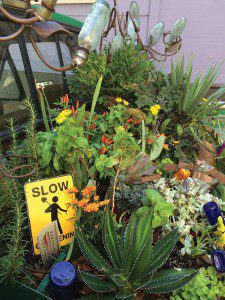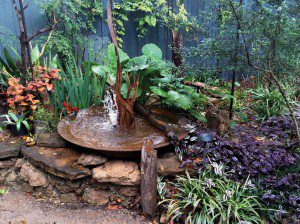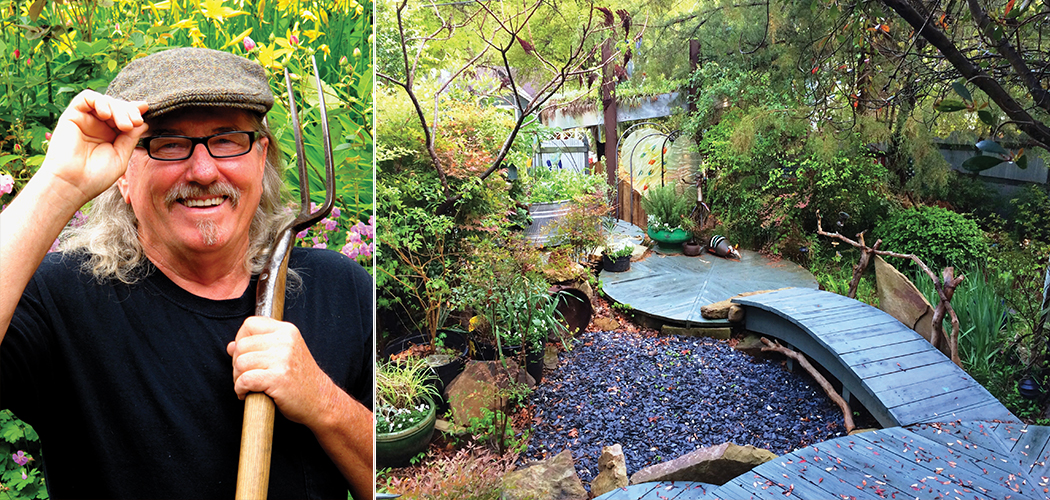[title subtitle=”words: Marla Cantrell
Images: courtesy Felder Rushing”][/title]
When Felder Rushing—horticulturist, humorist, and homespun philosopher—shows up in Fort Smith, Arkansas next month to speak at a free lecture hosted by the River Valley Master Gardeners, he’ll be driving his 1988 Ford F-150.
 A pickup of that vintage might not garner a lot of attention in the South where old trucks are as common as chiggers, but Felder’s Ford is different. Its bed is filled with rich soil and planted tightly with herbs and vegetables. And Felder, who believes every garden deserves a heavy dose of art, even has bottle trees anchored amidst those hearty plants.
A pickup of that vintage might not garner a lot of attention in the South where old trucks are as common as chiggers, but Felder’s Ford is different. Its bed is filled with rich soil and planted tightly with herbs and vegetables. And Felder, who believes every garden deserves a heavy dose of art, even has bottle trees anchored amidst those hearty plants.
“I’m hard-core South,” Felder says, in reference to the truck and the bottle tree, a staple of his childhood in Sunflower County, Mississippi. On trips through the area, he passed homesteads where slender cobalt-blue bottles had been slipped onto bare branches, turning an otherwise desolate tree or bush into something ethereal and lovely.
When he discovered the intricate work of sculptor and glass artist Dale Chihuly, whose pieces consist of bright colored glass formed into long spirals, he felt a connection.
“Bottle trees,” Felder says, “are just Redneck Chihuly. They both hold glass up to the sky so the colors can sing. The only difference is style and price.” He laughs, and the sound of it fills the space. Felder, it seems, is one happy man.
That happiness is rooted in gardening. Specifically, Slow Gardening, a subject he wrote a book about. If you’ve not heard the term, it’s a freeing concept, taking away all judgment about what is and isn’t right. “Have fun!” Felder says. “Enjoy yourself! Home gardening is like home cooking. Horticulture is the same as what a trained chef does at a fine restaurant.” The message here is that anyone can be a home cook but training to be a chef is full of rules and calculations and long, hard hours.
“Think of gardening as a buffet,” Felder says, continuing the food analogy. “You won’t have on your plate what other people have on theirs. If you have beet juice running into your mashed potatoes, who cares? My approach to garden design is like food at a church social. All the best food from all the different people, and maybe none of it matches.”
Proof that he believes what he says rests in his garden at his home in Jackson, Mississippi. There, in a neighborhood Felder describes as “funky-artsy-fartsy,” he’s transformed his lawn, all 350 square feet in the front, and 350 sqare feet in the back, into a marvel of hardy flowers, water features, a tiny cabin, and fruits and vegetables, all living together in a wild dance of texture and color. Add to that a crepe myrtle he sometimes spray paints and hangs Mardi Gras beads from, several garden gnomes, a flock of plastic pink flamingos, and a few old tire planters, and you start to understand just how serious this funny man is about not taking yourself, or your garden too seriously.
His story, and his laissez-faire attitude, started years ago. As a child, he lived across the street from his great-grandmother, a horticulturist who bred daffodils. “I used to putter around with her,” Felder says. “She had like 350 kinds of daffodils. I still have about two dozen of her daffodils that are still blooming.
 “When she would have a caterpillar on one of her flowers, instead of killing it, she would point out the weirdness of it and tell me what kind of butterfly it turned into. She taught me plenty about horticulture, but she did more than that. And I’ve always been attracted to people who teach real lessons instead of ‘by the rules’.”
“When she would have a caterpillar on one of her flowers, instead of killing it, she would point out the weirdness of it and tell me what kind of butterfly it turned into. She taught me plenty about horticulture, but she did more than that. And I’ve always been attracted to people who teach real lessons instead of ‘by the rules’.”
One of those lessons is about building a compost heap. While he knows the science behind what makes one work effectively, he doesn’t fret over the proper ratios of water, carbon, nitrogen and oxygen. Instead, he takes a corner in his yard, piles up organic matter—everything from egg shells, weeds, and banana peels—and lets it rest. “I even buried a dead raccoon in there once, and the next spring it was just bones and teeth. I figure that’s what happens in the woods, so why not try it there.”
This demystification is one of the best things about Felder’s plan to get people gardening. “Dig a little hole,” he says. “Put a plant in it, green side up. Water it.” That’s it. Three easy steps.
If you’re worried about garden design, that too is simple. “Take something round and put it with something spiky, and then put those two things with something frilly.”
Good advice, given by a man who attended a university to learn all the hard stuff so you don’t have to. He has opinions about just about everything, from the controversy over pruning crepe myrtles (Prune them if you want to. The Japanese have been doing it for more than 500 years.) to roses (“Even a dead man can grow a rose,” he says, and laughs, citing the abundance of wild roses in old southern cemeteries and abandoned homesteads.).
Today, this author or co-author of eighteen books, and radio personality, divides his time between his home in Mississippi and his place in England. “I love the cottage gardens in England,” Felder says, “because people do exactly what they want to do. No one’s in lockstep with anybody else. They have so much freedom.”
No matter which continent he’s on, he often thinks of his great-grandmother, the woman who took him under her wing and showed him the miracle of seeds and bulbs and the way the leaves of grand old trees cast lacy shadows across everything below.
 Felder wonders what she would think of the career he’s made. If he could see her again, he’d ask her. “I think we’d sit around the table and laugh about it, while we made fig preserves together. We might be bagging up seeds to give to people. But we’d sure enough be telling stories and joking.”
Felder wonders what she would think of the career he’s made. If he could see her again, he’d ask her. “I think we’d sit around the table and laugh about it, while we made fig preserves together. We might be bagging up seeds to give to people. But we’d sure enough be telling stories and joking.”
Felder pauses for a second, the first time during this interview. This talk of his great-grandmother, the woman who grew so many daffodils, seems to have hit him in the heart. He mentions that he’s growing daffodils in a bowl of water right now, but instead of the usual stones most put in the container, he’s used Mardi Gras beads. He thinks his great-grandmother would get a kick out of that. Felder laughs again. He’s almost certain she would.
Felder Rushing, Slow Gardening Expert
Free Lecture sponsored by the River Valley Master Gardeners
Thursday, April 28, 7PM
Fort Smith Convention Center
For more information, call 479.484.7737
For more on the Slow Gardening movement, visit slowgardening.net, or felderrushing.net.
This is the twenty-fifth anniversary of the River Valley Master Gardeners, a group of approximately 175 members. To find out how to join, contact Lance Kirkpatrick, Sebastian County Extension Agent. 479.484.7737.




